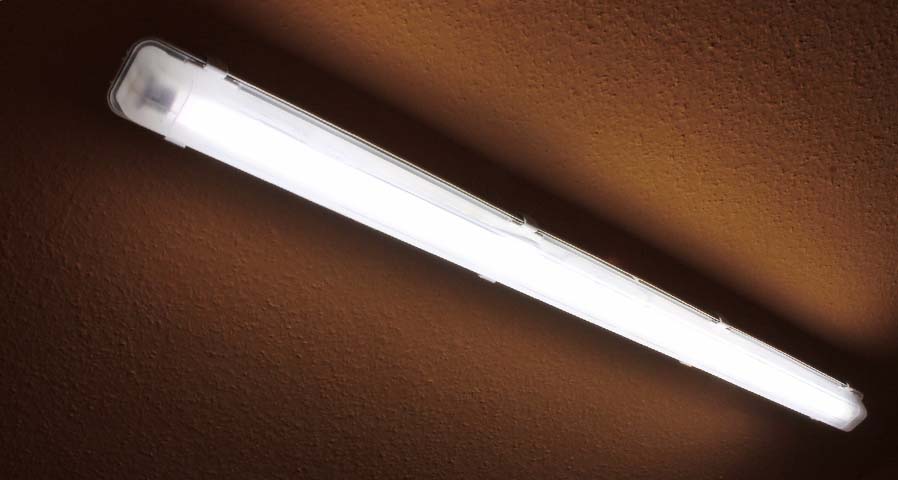Fluorescent lighting has been a common fixture in commercial and industrial spaces for decades. Known for being more efficient than incandescent bulbs, fluorescent lights, especially 8ft fluorescent tubes, have illuminated offices, warehouses, and schools for years. However, as technology advances, many facility managers are now reconsidering their lighting options, especially when replacing fluorescent tubes with LEDs.
In this article, we explore the differences between fluorescent tubes and LED lighting, and why upgrading to LEDs might be the best decision for your facility.
How Do Fluorescents Work?
Fluorescent lights are part of the High-Intensity Discharge (HID) family. As such, they produce light using a type of gas-discharge. Fluorescent lighting works by passing an electric current through a tube filled with low-pressure mercury vapor. Inside the tube, the electric current excites the mercury atoms, causing them to emit ultraviolet (UV) light. This UV light is invisible to the human eye, so a phosphor coating on the inside of the tube converts the UV light into visible light. When the UV rays strike the phosphor, it glows and produces the soft white light commonly associated with fluorescent bulbs. This process is more energy-efficient than traditional incandescent lighting.
Did you know we have an entire blog dedicated to comparing the differences between fluorescents and LEDs? In our blog; Fluorescent Tubes vs. LED, we take an in-depth look at how the 2 lights compare, including energy savings, maintenance savings, and performance.
Why It May Be Time for Your 8ft Fluorescent Tubes to Be Replaced
Firstly, fluorescent tubes are known to be difficult to work with. Due to their size and material, they are extremely expensive and difficult to ship. The tube’s length and glass material result in higher shipping rates, with no guarantee they won’t break before arrival. Their fragility also makes it hard for facilities to replace their lighting during maintenance checks and making room for the 8-foot tubes in storage can be problematic. Plus, the mercery content inside raises its own set of issues. In the event a fluorescent tube breaks, the mercury could be inhaled by people nearby. The mercury content means the tubes need to be recycled properly because it cannot go into a typical landfill.
Here is the list of problems customers often run into with the fluorescent tubes.
- Fluorescent tubes break easily. Preventing an all-glass 8ft long tube from breaking during installation or shipping is a difficult task.
- Shipping is expensive. The tube’s length and glass construction mean higher shipping rates, and it still doesn’t guarantee it will arrive in one piece.
- Storage is tricky. It’s hard finding a safe place to store fluorescent tubes.
- Not energy efficient. Most fluorescent tubes are not energy-efficient. Switching to LEDs not only saves on energy costs, but it can also reduce maintenance expenses.
- You have to recycle fluorescent tubes. Fluorescent lamps contain mercury that cannot go into landfills. You have to find a recycling facility that accepts the long tubes
Fluorescent lighting’s performance does not match LEDs. LEDs have a lifespan of at least 50,000 hours while a fluorescent tube only reaches 20,000. As fluorescent tubes reach the end of their lifespan, they begin to flicker and become less efficient. Fluorescents consume much more electricity than an LED because internal gases need to heat to emit light. They are also omnidirectional, meaning they produce light in 360 degrees. This creates significant system inefficiency, as at least half of the light must be reflected and redirected to the intended area, resulting in substantial losses. Because omnidirectional lights require this reflection, their output is far less efficient than a light source that is inherently directional. Additionally, more components are needed in the fixture to reflect or focus the light, which increases the overall cost of the unit.
Switching to LEDs
LEDs (Light Emitting Diodes) emit light through a process called electroluminescence. When an electrical current passes through the LED, it flows through a semiconductor material. This material contains electrons that become excited by the electrical energy. As these electrons move and settle into lower energy states, they release energy in the form of light. The color of the light depends on the materials used in the semiconductor. Even though LEDs can have a higher upfront cost, their benefits lead to long-term savings.
Energy Savings
LEDs are considered the most energy-efficient lighting option on the market. Unlike most lighting, LEDs do not require heat to produce light therefore they don’t use as much electricity. Fluorescents use gases to produce their lighting which means they need time to warm up and maintain a certain temperature before light appears, whereas LEDs reach maximum lighting performance immediately without using extra electricity. Since they also emit heat with their lighting, facilities using fluorescent tubes need their cooling systems to work harder than they would if they used LEDs. LED lighting helps commercial facilities cut down on energy usage resulting in exceptional cost savings as well.
Maintenance Savings
When comparing the maintenance needs of linear LEDs to fluorescent tubes, LEDs are the clear winner. Fluorescent tubes generally last between 3 and 5 years, but their internal ballasts are fragile. If the ballast is damaged, the tube stops working altogether. Even if the ballast remains intact, fluorescent tubes experience light degradation toward the end of their lifespan, with flickering and darkened ends—issues that can lead to headaches, eye strain, and other health concerns.
In contrast, LEDs have a lifespan of 50,000 to 100,000 hours and are significantly easier to maintain. Unlike fluorescents, LEDs don’t rely on fragile ballasts, making them less prone to sudden failures. Built with durable materials and solid-state diode technology, LEDs can handle much more wear and vibration. This makes them ideal for environments where reliability is crucial. Additionally, LEDs require fewer replacements, reducing the frequency of maintenance and the associated labor costs. Some manufacturers are so confident in their durability that they offer up to 10-year warranties on their LED lamps.
Performance
LEDs even surpass fluorescent tubes in performance. LEDs can produce a broader spectrum of light which encompasses the entire color wheel, making them more customizable to a consumer’s needs. This allows more precise color temperature to suit a business’s aesthetics and goals whereas fluorescent has a limited color spectrum. They tend to distort the room the illuminate by making it look too artificial and can lead to visual discomfort.
In terms of brightness, LEDs outperform fluorescents significantly. Fluorescent lights generally produce between 50 and 100 lumens per watt, while LEDs can deliver around 130 lumens per watt. For instance, a T5HO LED tube light uses only 25 watts to achieve an impressive 3,334 lumens, demonstrating how LEDs are more energy-efficient and capable of producing brighter light with less power.
LEDs are compatible with lighting controls and smart technology to help make the facility more efficient. By advancing LEDs with lighting controls, such as dimmers, sensors and daylighting, facility managers have more flexibility and control over the lighting, plus see more energy savings.
Replacement Options for 8 Foot Fluorescent Tubes
Here are a few replacement options for your bulky 8ft fluorescent tubes.
- LED retrofit kits. You don’t have to replace the lighting fixtures with an LED retrofit kit. Everything fits into your existing ballast, including the brackets and sockets. The retrofit kit is LED compatible, so you get a more durable lighting product and reduce energy usage.
- Transition to 4ft LED tubes. Have you considered transitioning to 4ft LED tubes? Two of the LED tubes will fit in your existing 8ft ballast. You can keep your existing light fixtures and save money on energy use. The shorter tubes are also easier to store and replace.
- Use a 4ft fluorescent retrofit kit. You are losing out on energy usage savings with a fluorescent retrofit kit. Mercury is also a problem, you still have to recycle the shorter tubes, but it will make replacing the tubes a little easier for your maintenance team. Using shorter fluorescent tubes also helps prevent breakage, but you are losing out on the benefits you get by switching to LED lighting. You also need to take into consider there could eventually be a global fluorescent ban.
- Replace 8 foot fluorescent tubes with LED lamps. Replacing your current fixtures with LED lighting is expensive, but you also see the highest return on your investment. Energy costs are lower, and the LEDs need replacing less often. You can also take advantage of rebates, warranties, and other financial incentives to help offset the installation costs.
Upgrading to LEDs with Action Services Group
Fluorescent tubes are beginning to be phased out and replaced by a new popular choice, LED lighting. With its exceeding performance, cost, and energy savings, property managers are choosing to retrofit their buildings with LEDs. Their technological advancements also allow them to be integrated with networked lighting controls and even full building controls to improve functionality.
Action Services Group offers LED retrofit solutions to commercial properties looking to lower energy usage, save money and better their lighting environment. To speak with one of our specialists, call 610-558-9773, email [email protected], or schedule a call that fits your needs by clicking the button below.








































0 Comments